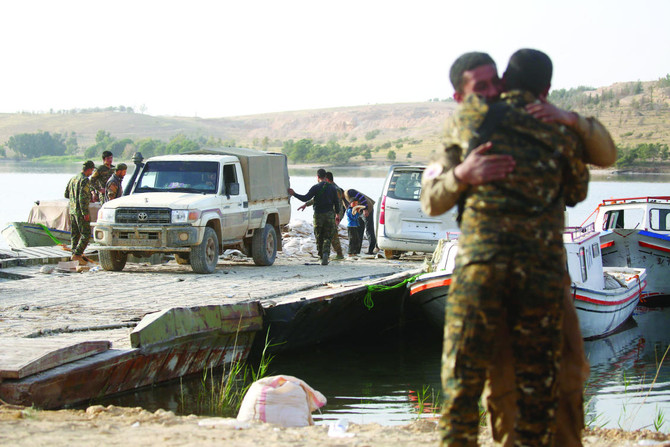LAKE ASSAD, Syria: As US-backed fighters advance on Daesh’s de facto Syrian stronghold Raqqa, a waterway “corridor” has become a key supply line, and an escape route for displaced civilians.
An AFP team accompanied fighters from the Syrian Democratic Forces (SDF), a Kurdish-Arab alliance that is fighting to capture the strategic town of Tabqa, some 55 km west of Raqqa.
Their direct land route from the territory they hold in the north is blocked by the Tabqa dam, which remains under Daesh control.
So instead, they are running supplies across Lake Assad, an enormous reservoir created by the dam, as well as ferrying civilians fleeing Tabqa back across to safety.
The main means of transport is a makeshift ferry, made out of a piece of floating bridge that has been lashed to four small boats, two on each side.
The boats, borrowed from local fishermen and attached with orange rope, drive the “ferry” and its occupants across the lake multiple times a day on an hour-long journey.
On Saturday, several dozen civilians waited on the northern side of the lake, hours after crossing to safety, as fighters loaded up the floating bridge moored near the Jaabar Castle, a local historical site.
A woman in her 30s, her face loosely wrapped in a beige headscarf, distributed bread to her children in the back of a pick-up truck.
Nearby, a child and his father stood by the water’s edge, washing their faces after an exhausting trip. A rusty boat bobbed by them in the shallows.
Many of the arrivals looked exhausted, and some still seemed afraid, wary of their new surroundings.
“We were besieged in Tabqa. The humanitarian situation was really bad,” said Ismail Mohamed, 39, who had arrived hours earlier with his family.
“People are hungry and tired. Everyone is psychologically shattered, crushed,” he said. “When we got on the water, riding the boat, we truly couldn’t believe it, we were so happy.”
As the arrivals waited for permission to move north into SDF-held territory, fighters loaded vehicles with food and other supplies, and drove them onto the makeshift ferry.
“The dam is not safe yet, we don’t control it fully. There are still some mercenaries there, so we can’t move civilians through,” an SDF commander said, referring to Daesh terrorists. “So we have opened a water corridor to rescue civilians, including via small boats and this ferry,” he said.
Fighters offered civilians loaves of flat bread as they waited.
The makeshift craft relies on local fishermen who have lent the SDF their boats. The hour-long trip to the southern shore, where more civilians are waiting to escape, is a sharp contrast with the fierce fighting that awaits SDF forces in Tabqa.
The US-backed force now controls more than 50 percent of the town, but has faced fierce resistance from Daesh, with the terrorists deploying suicide attackers, car bombs and weaponized drones.
Capturing Tabqa will be a key step toward the advance on Raqqa, which the SDF is seeking to encircle before beginning a final assault.
On the water though, there is little sound except the engines of the boats and the thump of two US-led coalition helicopters overhead, helping secure the corridor.
As the craft moved forward, the sun began to set, with the almost-still water reflecting the orange rays.
Relaxed fighters, men and women, sipped tea and took photos, some looking toward the smoke rising from Tabqa in the distance. “There is no fear like there was before,” said SDF fighter Amed Qamishlo.
“Daesh has begun to collapse in Tabqa, and now things are good compared to how they were,” he said.
A waterway lifeline for US-backed Syria force fighting Daesh
A waterway lifeline for US-backed Syria force fighting Daesh











